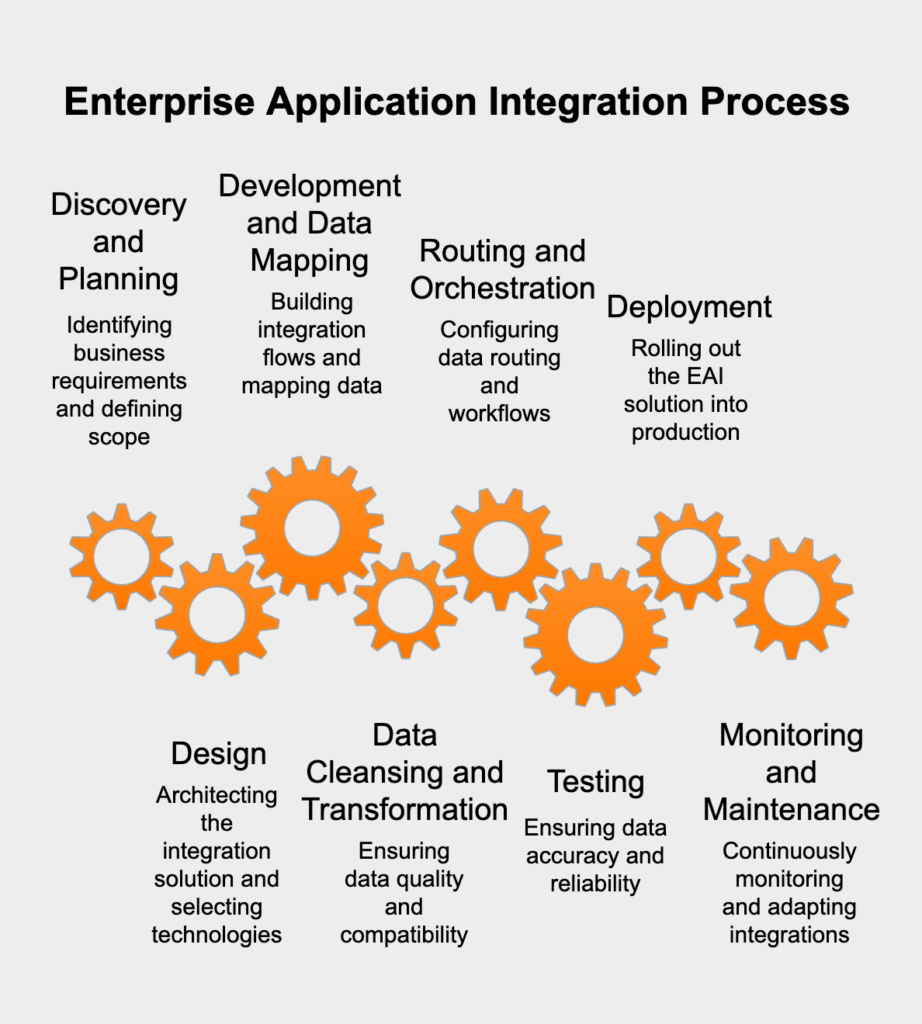How system integration in retail solves issues with inventory management
- June 25
- 5 min

Enterprise Application Integration (EAI) tackles the stubborn problem of information silos that plague modern businesses. When specialized systems like CRM, ERP, supply chain, and HR platforms can’t talk to each other, companies suffer from fragmented data and inefficient workflows. Staff waste countless hours on manual data re-entry, errors multiply, and managers lack the comprehensive view needed for smart decisions. These disconnected “islands of automation” or “stovepipe systems” don’t just frustrate employees—they actively undermine business agility and make seamless end-to-end processes nearly impossible to achieve. The resulting operational friction creates a tangible drag on performance that EAI specifically addresses.
Enterprise Application Integration (EAI) represents both a strategic approach and technological framework that connects diverse systems across an organization, enabling them to work together as a cohesive unit. More than just connecting wires, EAI encompasses the processes, software tools, and architectural principles that enable automated information exchange between previously isolated systems. Rather than forcing complete application rewrites, EAI creates pathways for data and functionality sharing while preserving existing infrastructure investments. As Gartner puts it, EAI enables “the unrestricted sharing of data and business processes among any connected application or data sources in the enterprise.” The result isn’t just technical connectivity—it’s a more unified and responsive operational environment that breaks down traditional departmental barriers.
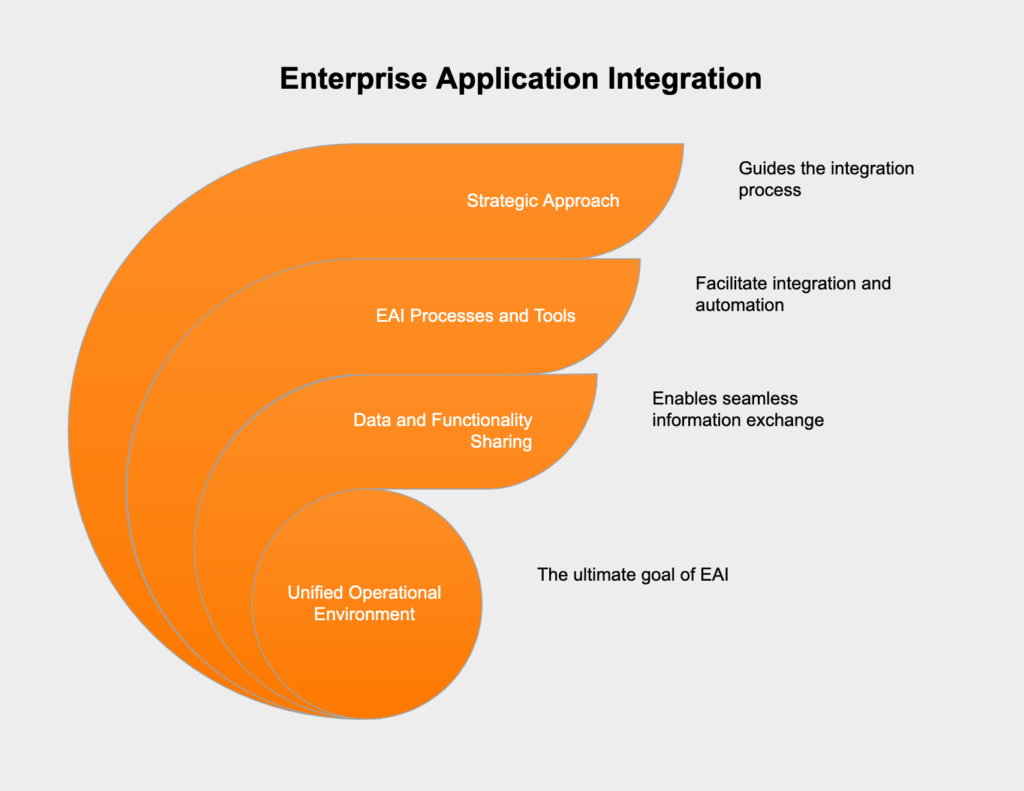
The primary objectives of implementing Enterprise Application Integration extend beyond simple connectivity. EAI aims to transform how an organization’s technology landscape supports its business goals by breaking down information silos and creating seamless data flows between applications. It automates cross-system business processes, reducing manual work and operational delays while delivering a unified and consistent view of enterprise data that improves quality and decision-making. EAI also boosts business agility, making it easier to adapt to market shifts, launch new services, or modify existing processes. By reducing data redundancy and eliminating costly manual handling, it drives significant operational efficiencies across the organization.
EAI stands apart from basic point-to-point connections between applications. While direct links between two systems might seem simpler initially, this approach quickly becomes a maintenance nightmare as application numbers grow, creating an unmanageable “spaghetti architecture” that’s brittle, difficult to maintain, and expensive to modify. Instead, EAI provides a more holistic and strategic framework, typically employing centralized integration infrastructure (middleware) that standardizes connections and communications. This approach delivers greater scalability, lets integration logic be reused, and enables centralized management—treating integration as an architectural discipline rather than a series of one-off connections.
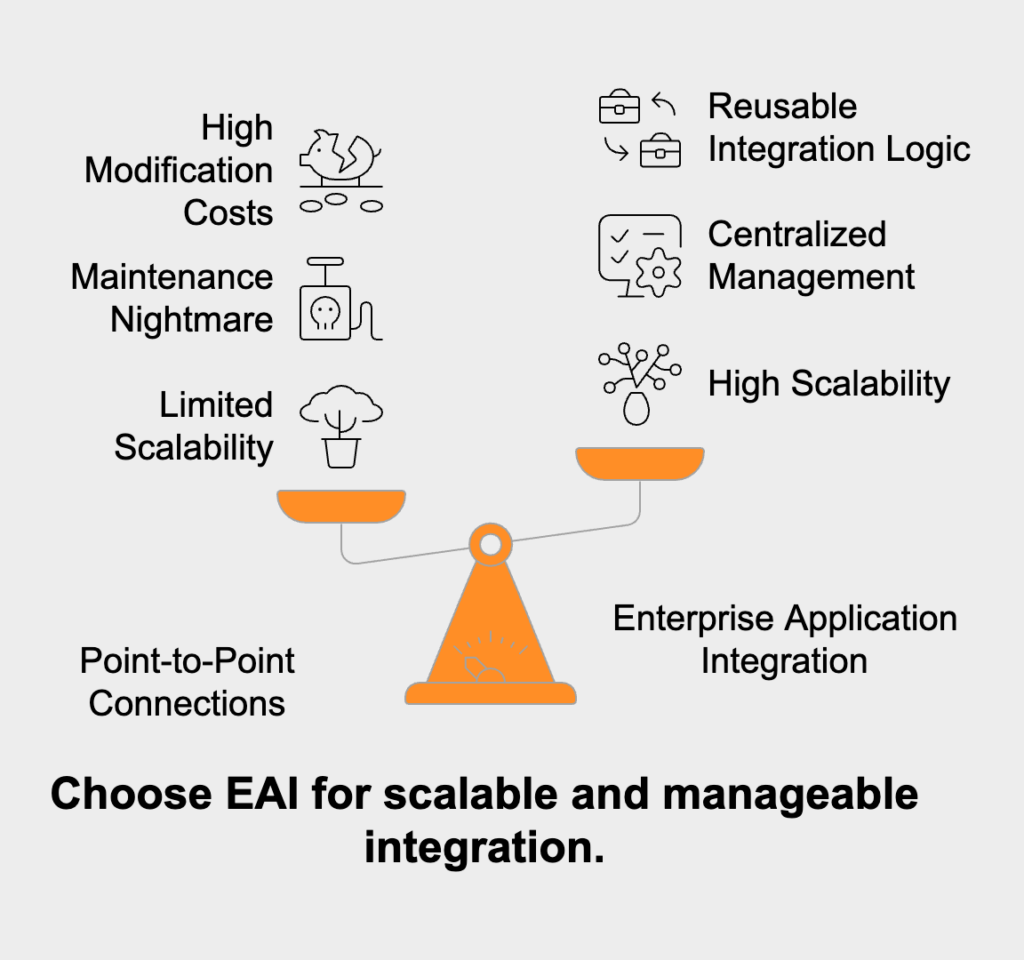
At its core, EAI creates a communication backbone that lets diverse software systems talk to each other regardless of their underlying technology, platform, or vendor. Most implementations rely on a middleware layer that acts as an interpreter between different application languages. When something happens in one system—say a sales rep adds a new customer in the CRM—the EAI solution captures this event, transforms the data into formats other systems can understand, and routes it to relevant destinations like billing and marketing platforms. This creates automated workflows where changes ripple through the organization in real-time or near-real-time, keeping everything in sync. The connections typically happen through APIs (Application Programming Interfaces) for back-end systems, though some solutions can also integrate with front-end interfaces when necessary.
Middleware serves as the critical connective tissue in most EAI strategies. This “glue” layer simplifies integration development and management by providing essential services like message queuing (through Message-Oriented Middleware or MOM), data transformation, protocol conversion, transaction management, and security features. Many organizations implement an Enterprise Service Bus (ESB)—a specialized middleware that creates a communication system between applications in a service-oriented architecture (SOA). APIs play an equally fundamental role by exposing standardized interfaces to application data and functionality, which the middleware can then orchestrate into coherent business processes.
Data management forms the beating heart of effective EAI. Since applications rarely speak the same language—using different formats, schemas, and data definitions—EAI solutions must bridge these gaps to ensure compatibility. This involves several crucial processes: data extraction pulls information from source systems; data cleansing fixes inaccuracies and inconsistencies; data transformation converts information between formats or into a common model; and data routing ensures the transformed information reaches the right destination systems based on business rules. Together, these processes maintain data consistency and accuracy across integrated systems, supporting a reliable single source of truth for the entire organization.
EAI architects typically choose from several established integration patterns based on factors like the number of applications involved, business process complexity, and scalability needs. Two fundamental approaches stand out: point-to-point integration and hub-and-spoke integration.
Point-to-point (P2P) integration creates direct connections between pairs of applications that need to exchange data. Each integration link is custom-built and maintained separately. While this approach works well enough for connecting a handful of systems, it breaks down spectacularly as application counts rise. The math tells the story—with N applications, you potentially need N*(N-1)/2 separate connections. A modest 10-application landscape could require 45 distinct integrations! This quickly becomes a maintenance nightmare, creating brittle “spaghetti code” that’s expensive to maintain and resistant to change.
The hub-and-spoke integration model elegantly solves the scalability problems of point-to-point by introducing a central integration engine—the hub. Applications (spokes) connect only to this central hub rather than directly to each other. The hub handles message routing, data transformation, and orchestration between systems. This dramatically simplifies the integration landscape, as adding or removing an application only affects its single connection to the hub. The centralized design promotes reuse of integration logic and provides a single point for monitoring and control. For most enterprises with more than a handful of applications, hub-and-spoke delivers significantly better manageability and scalability than the P2P approach.
Implementing Enterprise Application Integration offers significant strategic and operational advantages to organizations. By integrating disparate systems and automating data flows, EAI empowers businesses in several key ways:
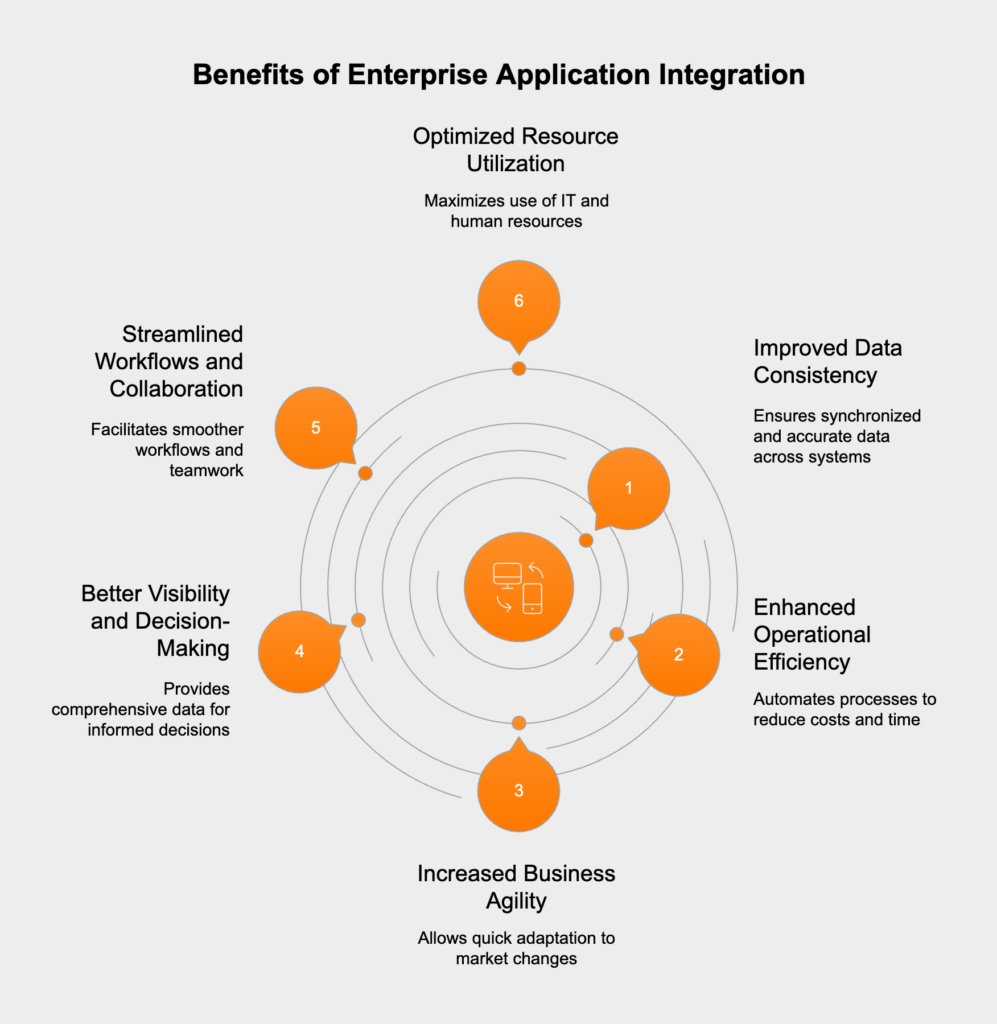
A wide array of enterprise systems across various departments can benefit significantly from Enterprise Application Integration. The primary candidates are systems that hold critical business data or drive key business processes, and where sharing this information can lead to greater efficiency or new capabilities. Common examples include:
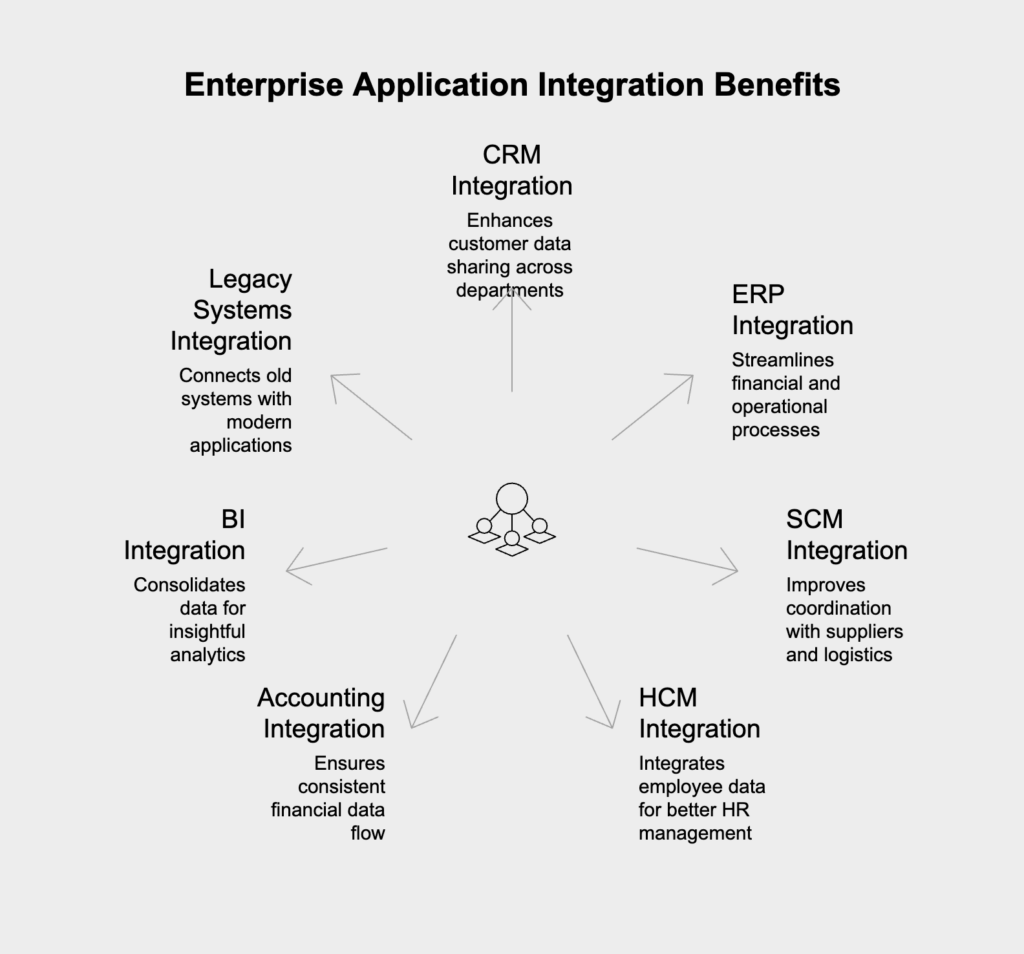
The implementation of an Enterprise Application Integration solution is a structured process that typically involves several key stages. While specifics can vary based on the chosen methodology and tools, a general approach includes the following steps:
